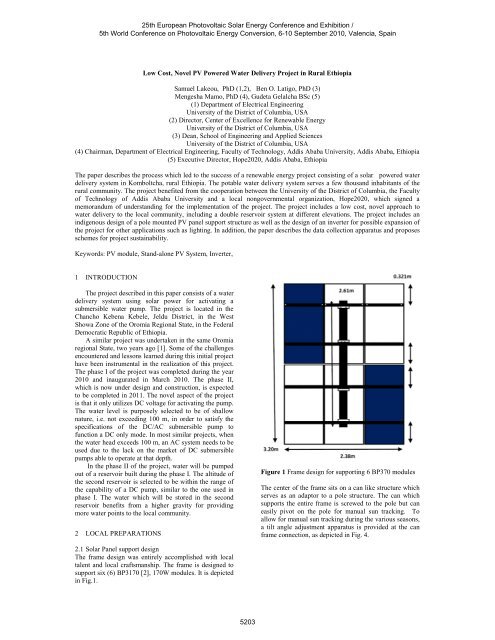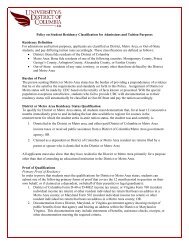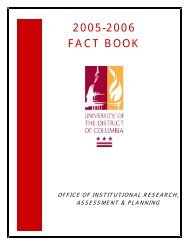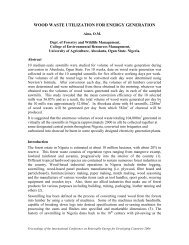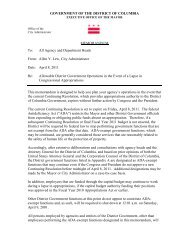Low Cost, Novel PV Powered Water Delivery Project in Rural Ethiopia
Low Cost, Novel PV Powered Water Delivery Project in Rural Ethiopia
Low Cost, Novel PV Powered Water Delivery Project in Rural Ethiopia
You also want an ePaper? Increase the reach of your titles
YUMPU automatically turns print PDFs into web optimized ePapers that Google loves.
25th European Photovoltaic Solar Energy Conference and Exhibition /<br />
5th World Conference on Photovoltaic Energy Conversion, 6-10 September 2010, Valencia, Spa<strong>in</strong><br />
<strong>Low</strong> <strong>Cost</strong>, <strong>Novel</strong> <strong>PV</strong> <strong>Powered</strong> <strong>Water</strong> <strong>Delivery</strong> <strong>Project</strong> <strong>in</strong> <strong>Rural</strong> <strong>Ethiopia</strong><br />
Samuel Lakeou, PhD (1,2), Ben O. Latigo, PhD (3)<br />
Mengesha Mamo, PhD (4), Gudeta Gelalcha BSc (5)<br />
(1) Department of Electrical Eng<strong>in</strong>eer<strong>in</strong>g<br />
University of the District of Columbia, USA<br />
(2) Director, Center of Excellence for Renewable Energy<br />
University of the District of Columbia, USA<br />
(3) Dean, School of Eng<strong>in</strong>eer<strong>in</strong>g and Applied Sciences<br />
University of the District of Columbia, USA<br />
(4) Chairman, Department of Electrical Eng<strong>in</strong>eer<strong>in</strong>g, Faculty of Technology, Addis Ababa University, Addis Ababa, <strong>Ethiopia</strong><br />
(5) Executive Director, Hope2020, Addis Ababa, <strong>Ethiopia</strong><br />
The paper describes the process which led to the success of a renewable energy project consist<strong>in</strong>g of a solar powered water<br />
delivery system <strong>in</strong> Komboltcha, rural <strong>Ethiopia</strong>. The potable water delivery system serves a few thousand <strong>in</strong>habitants of the<br />
rural community. The project benefited from the cooperation between the University of the District of Columbia, the Faculty<br />
of Technology of Addis Ababa University and a local nongovernmental organization, Hope2020, which signed a<br />
memorandum of understand<strong>in</strong>g for the implementation of the project. The project <strong>in</strong>cludes a low cost, novel approach to<br />
water delivery to the local community, <strong>in</strong>clud<strong>in</strong>g a double reservoir system at different elevations. The project <strong>in</strong>cludes an<br />
<strong>in</strong>digenous design of a pole mounted <strong>PV</strong> panel support structure as well as the design of an <strong>in</strong>verter for possible expansion of<br />
the project for other applications such as light<strong>in</strong>g. In addition, the paper describes the data collection apparatus and proposes<br />
schemes for project susta<strong>in</strong>ability.<br />
Keywords: <strong>PV</strong> module, Stand-alone <strong>PV</strong> System, Inverter,<br />
1 INTRODUCTION<br />
The project described <strong>in</strong> this paper consists of a water<br />
delivery system us<strong>in</strong>g solar power for activat<strong>in</strong>g a<br />
submersible water pump. The project is located <strong>in</strong> the<br />
Chancho Kebena Kebele, Jeldu District, <strong>in</strong> the West<br />
Showa Zone of the Oromia Regional State, <strong>in</strong> the Federal<br />
Democratic Republic of <strong>Ethiopia</strong>.<br />
A similar project was undertaken <strong>in</strong> the same Oromia<br />
regional State, two years ago [1]. Some of the challenges<br />
encountered and lessons learned dur<strong>in</strong>g this <strong>in</strong>itial project<br />
have been <strong>in</strong>strumental <strong>in</strong> the realization of this project.<br />
The phase I of the project was completed dur<strong>in</strong>g the year<br />
2010 and <strong>in</strong>augurated <strong>in</strong> March 2010. The phase II,<br />
which is now under design and construction, is expected<br />
to be completed <strong>in</strong> 2011. The novel aspect of the project<br />
is that it only utilizes DC voltage for activat<strong>in</strong>g the pump.<br />
The water level is purposely selected to be of shallow<br />
nature, i.e. not exceed<strong>in</strong>g 100 m, <strong>in</strong> order to satisfy the<br />
specifications of the DC/AC submersible pump to<br />
function a DC only mode. In most similar projects, when<br />
the water head exceeds 100 m, an AC system needs to be<br />
used due to the lack on the market of DC submersible<br />
pumps able to operate at that depth.<br />
In the phase II of the project, water will be pumped<br />
out of a reservoir built dur<strong>in</strong>g the phase I. The altitude of<br />
the second reservoir is selected to be with<strong>in</strong> the range of<br />
the capability of a DC pump, similar to the one used <strong>in</strong><br />
phase I. The water which will be stored <strong>in</strong> the second<br />
reservoir benefits from a higher gravity for provid<strong>in</strong>g<br />
more water po<strong>in</strong>ts to the local community.<br />
2 LOCAL PREPARATIONS<br />
Figure 1 Frame design for support<strong>in</strong>g 6 BP370 modules<br />
The center of the frame sits on a can like structure which<br />
serves as an adaptor to a pole structure. The can which<br />
supports the entire frame is screwed to the pole but can<br />
easily pivot on the pole for manual sun track<strong>in</strong>g. To<br />
allow for manual sun track<strong>in</strong>g dur<strong>in</strong>g the various seasons,<br />
a tilt angle adjustment apparatus is provided at the can<br />
frame connection, as depicted <strong>in</strong> Fig. 4.<br />
2.1 Solar Panel support design<br />
The frame design was entirely accomplished with local<br />
talent and local craftsmanship. The frame is designed to<br />
support six (6) BP3170 [2], 170W modules. It is depicted<br />
<strong>in</strong> Fig.1.<br />
5203
25th European Photovoltaic Solar Energy Conference and Exhibition /<br />
5th World Conference on Photovoltaic Energy Conversion, 6-10 September 2010, Valencia, Spa<strong>in</strong><br />
Figure 4 Manual sun track<strong>in</strong>g adjustment scheme.<br />
A local metal worker was commissioned to build the<br />
structure, <strong>in</strong>clud<strong>in</strong>g the adaptor can, with steel purchased<br />
on the local market. The cost of the frame was almost an<br />
order of magnitude lower than the one used <strong>in</strong> the Ambo<br />
project [1], which was purchased from a company <strong>in</strong> the<br />
US. The locally built structure and the adaptor can are<br />
shown <strong>in</strong> Figs. 2 and 3 respectively.<br />
Figure 5. Panel support frame assembly.<br />
2.2 Panel support pole design.<br />
The support pole was designed to withstand local<br />
w<strong>in</strong>d conditions and storm w<strong>in</strong>ds up to 100m/s. Six feet<br />
underground and six feet above ground were considered<br />
to be the most suitable dimensions for the desired<br />
specifications. The pole was built with steel re<strong>in</strong>forced<br />
concrete, us<strong>in</strong>g local talent and is depicted <strong>in</strong> Fig. 6<br />
Figure 2. Panel support frame structure with steel<br />
Figure 6. Frame support concrete pole<br />
Figure 3. Adaptor Can built with steel (held by the<br />
author)<br />
The f<strong>in</strong>al pole-mounted module support structure,<br />
<strong>in</strong>clud<strong>in</strong>g the control box, IO101 from Grundfos for<br />
pump ON/OFF and for monitor<strong>in</strong>g the delivered electric<br />
voltage from the modules is shown <strong>in</strong> Fig. 7.<br />
The f<strong>in</strong>al frame assembly with the angle adjuster and can<br />
adaptor is depicted <strong>in</strong> Fig. 5.<br />
5204
25th European Photovoltaic Solar Energy Conference and Exhibition /<br />
5th World Conference on Photovoltaic Energy Conversion, 6-10 September 2010, Valencia, Spa<strong>in</strong><br />
Figure 7. F<strong>in</strong>al pole-mounted module support structure<br />
with I200 control box.<br />
Figure 10. Access to the spr<strong>in</strong>g box<br />
In addition, the NGO, Hope2020 made all the necessary<br />
arrangements with the local community for secur<strong>in</strong>g land<br />
for the <strong>in</strong>stallation of the <strong>PV</strong> modules and for obta<strong>in</strong><strong>in</strong>g<br />
permission for the tap<strong>in</strong>g the spr<strong>in</strong>g water.<br />
3 SPRING BOX and RESERVOIR for phase I<br />
The reservoir and spr<strong>in</strong>g box were built<br />
simultaneously while the solar module support structure<br />
was be<strong>in</strong>g completed, all us<strong>in</strong>g local talent.<br />
3.1 Spr<strong>in</strong>g box and capp<strong>in</strong>g<br />
In phase I of the project, a 5.5 m long spr<strong>in</strong>g box and<br />
a 10 m 3 collection chamber were built. Figures 8, 9, 10<br />
and 11 show the spr<strong>in</strong>g box, the collection chamber, the<br />
spr<strong>in</strong>g box access and the f<strong>in</strong>ished, capped spr<strong>in</strong>g box,<br />
respectively.<br />
Figure 11. Capped spr<strong>in</strong>g box<br />
3.2 Reservoir for phase I<br />
A 15 m 3 reservoir was constructed at about 1,200 m<br />
on a higher ground (about 65m) from the collection<br />
chamber. The reservoir has 8 built-<strong>in</strong> water taps to<br />
accommodate eight villagers at a time.<br />
Figure 8. Construction of the spr<strong>in</strong>g box<br />
Figure 12. A 15 m 3 reservoir for phase I<br />
4. <strong>Water</strong> po<strong>in</strong>ts and distribution system<br />
Figure 9. Construction of the collection chamber<br />
4.1 Distribution<br />
A 2,500m water distribution HDPE pipe system was<br />
laid connect<strong>in</strong>g the water chamber at the spr<strong>in</strong>g level to<br />
the reservoir and back to two water po<strong>in</strong>ts. The soil<br />
5205
25th European Photovoltaic Solar Energy Conference and Exhibition /<br />
5th World Conference on Photovoltaic Energy Conversion, 6-10 September 2010, Valencia, Spa<strong>in</strong><br />
excavation for <strong>in</strong>stall<strong>in</strong>g the pipes and the back fill<strong>in</strong>g<br />
was entirely done with the help of the local volunteer<br />
villagers.<br />
4.2 <strong>Water</strong> po<strong>in</strong>ts<br />
Two water po<strong>in</strong>ts with six faucets each were <strong>in</strong>stalled<br />
at a convenient location for easy access by the local<br />
villagers. The faucets have been a major source of<br />
excitement and socialization for the locals, as depicted by<br />
Fig 13.<br />
• A 50 to 70 m 3 second reservoir at an altitude of<br />
about 60 m from the first reservoir;<br />
• A battery bank with a charge controller; and<br />
• A locally built <strong>in</strong>verter for provid<strong>in</strong>g<br />
220V/50Hz AC voltage to the villagers.<br />
Figure 15 Proposed phase II scheme<br />
Figure 13. <strong>Water</strong> po<strong>in</strong>t with six faucets<br />
The water was <strong>in</strong>spected and tested for potability by the<br />
Pasteur Institute <strong>in</strong> Addis Ababa.<br />
The phase I was <strong>in</strong>augurated d on March 3, 2010 as shown<br />
<strong>in</strong> Fig. 14<br />
4.2 Inverter design<br />
The proposed <strong>in</strong>verter is designed with <strong>in</strong>expensive<br />
and simple components, such as <strong>in</strong>sulated gate transistors<br />
and elementary logic circuit devices. The power supply<br />
for the gate driver circuitry is taped from the DC voltage<br />
generated by the solar panels. The 3-phase <strong>in</strong>verter is<br />
shown <strong>in</strong> Fig. 15 with its correspond<strong>in</strong>g tim<strong>in</strong>g diagram<br />
of the three voltages, V T,S,R available at the load.<br />
The fundamental component phase voltage generated by<br />
the <strong>in</strong>verter is expressed by equation 1 below; where V d<br />
is the DC voltage from the solar panels or battery.<br />
2Vdc<br />
Vp<br />
= s<strong>in</strong>(100πt<br />
)<br />
(1)<br />
π<br />
The root-mean-square phase voltage, V rms , is given by<br />
Vrms = 0. 45V dc<br />
. In order to obta<strong>in</strong> RMS l<strong>in</strong>e voltage of<br />
380 volts and phase voltage of 220 volts, the DC voltage<br />
from solar panels should be around 500 V. However,<br />
dur<strong>in</strong>g switch<strong>in</strong>g, the voltage across the switch<strong>in</strong>g<br />
devices is normally above this value due to the high rate<br />
of change of the current.<br />
Figure 14. Inauguration of phase I<br />
4 PROPOSED PHASE II<br />
4.1 Proposed scheme<br />
The phase II of the project is <strong>in</strong>tended to provide:<br />
• More water po<strong>in</strong>ts to the local villagers at a<br />
longer distance from the first village;<br />
• Electricity supply to the villagers for m<strong>in</strong>imal<br />
use such as light<strong>in</strong>g and mobile phone charg<strong>in</strong>g<br />
etc…<br />
The phase II of the project, which is shown <strong>in</strong> Fig. 15, 1<br />
will comprise the follow<strong>in</strong>g:<br />
• A pole-mounted solar module panel positioned<br />
next to the reservoir of phase I;<br />
• A submersible DC pump to be <strong>in</strong>stalled <strong>in</strong>side<br />
the reservoir of phase I;<br />
5206
25th European Photovoltaic Solar Energy Conference and Exhibition /<br />
5th World Conference on Photovoltaic Energy Conversion, 6-10 September 2010, Valencia, Spa<strong>in</strong><br />
Description Phase I Phase II<br />
(proposed)<br />
<strong>Water</strong> source Spr<strong>in</strong>g Reservoir<br />
Discharge 1.2 L/s TBD<br />
rate<br />
<strong>Water</strong> 10 m 3 None<br />
collection<br />
chamber<br />
Reservoir 15 m 3 50-75 m 3<br />
Reservoir<br />
altitude<br />
(head)<br />
<strong>Water</strong> faucets<br />
on reservoir<br />
65 m<br />
from spr<strong>in</strong>g<br />
8 8<br />
<strong>Water</strong> po<strong>in</strong>ts 2 6<br />
50m<br />
from<br />
reservoir<br />
<strong>Water</strong> faucets 6 6<br />
at water<br />
po<strong>in</strong>ts<br />
Distribution 2,500m 7,800 m<br />
pipe length<br />
Solar panels 6 BP 3170 50 BP185<br />
Population<br />
served<br />
Pump<br />
1,500 3,700<br />
DC/AC<br />
Grundfos<br />
DC/AC<br />
Grundfos<br />
Figure 15 Inverter circuit and correspond<strong>in</strong>g tim<strong>in</strong>g<br />
diagram.<br />
Controller<br />
box<br />
IO101<br />
Grundfos<br />
IO101<br />
Grundfos<br />
The <strong>in</strong>verter is <strong>in</strong>tended to supply AC power to be used<br />
by the villagers for light<strong>in</strong>g of homes or public build<strong>in</strong>gs<br />
and<br />
6. ENHANCEMENTS<br />
The follow<strong>in</strong>g enhancements will be considered:<br />
a. Remote access of the system for monitor<strong>in</strong>g the<br />
power as proposed <strong>in</strong> the project realized at the<br />
Farsi Senkele site <strong>in</strong> 2008 [3];<br />
b. <strong>Water</strong> delivery to a latr<strong>in</strong>e and public shower<br />
area; and<br />
c. Imposition of a m<strong>in</strong>imal water usage fee on the<br />
community <strong>in</strong> order to provide susta<strong>in</strong>ability.<br />
5 COMPARATIVE CHART<br />
The comparison between the ma<strong>in</strong> features of the phase I<br />
and the proposed phase II of the project is summarized <strong>in</strong><br />
table I.<br />
Battery bank None Size TBD<br />
Inverter None 3-Phase<br />
Local built<br />
<strong>Cost</strong> USD 35K USD 75 K<br />
Table I: Comparative chart between phase I and phase II<br />
7. Acknowledgements and Conclusion<br />
The support of BP Solar, through its module donation<br />
program [4] has been very useful for the realization of the<br />
program. A private “anonymous” donor from Northern<br />
Virg<strong>in</strong>ia, <strong>in</strong> the US has donated USD15K and his<br />
contribution is greatly appreciated. The US Scholar<br />
Fulbright Program has partially supported the author, Dr.<br />
Samuel Lakeou dur<strong>in</strong>g the implementation of the project.<br />
It is believed that the phase II of the project will<br />
materialize dur<strong>in</strong>g the course of 2011.<br />
8. References<br />
[1] S. Lakeou, Ben O. Latigo, Proceed<strong>in</strong>gs 24 th<br />
EU<strong>PV</strong>SEC, Successful Hybrid Solar and W<strong>in</strong>d Based<br />
Renewable Energy <strong>Project</strong> <strong>in</strong> <strong>Rural</strong> <strong>Ethiopia</strong><br />
[2]www.bp.com/liveassets/bp_<strong>in</strong>ternet/solar/bp.../d/BP31<br />
70N_G.pdf<br />
[3]S. Lakeou, Ben. O. Latigo, Proceed<strong>in</strong>gs, 23 rd<br />
EU<strong>PV</strong>SEC, Design of a Remote Power and Weather Data<br />
Monitor<strong>in</strong>g System for a Solar and W<strong>in</strong>d Based<br />
Renewable Energy Power Source: Application to a <strong>Water</strong><br />
<strong>Delivery</strong> <strong>Project</strong> <strong>in</strong> a <strong>Rural</strong> Community.<br />
[4]http://www.bp.com/sectiongenericarticle.do?categoryI<br />
d=9019564&contentId=7036655<br />
5207


